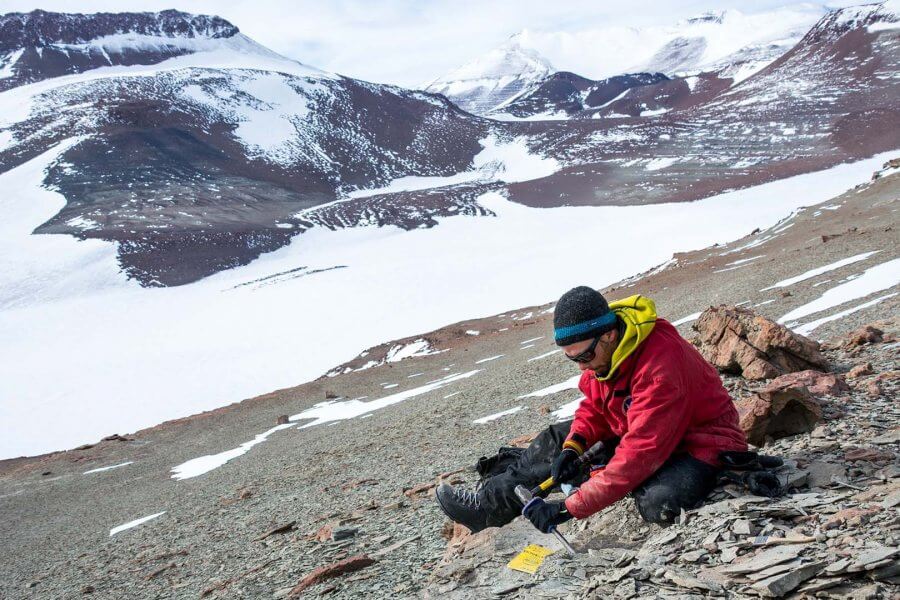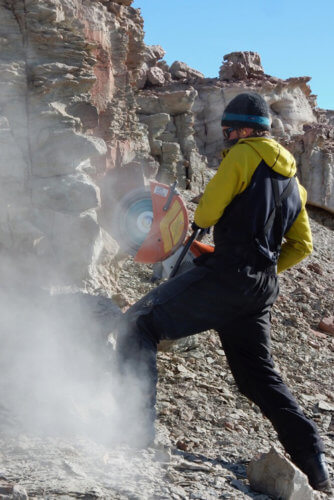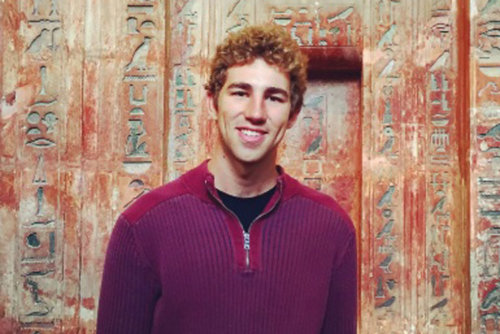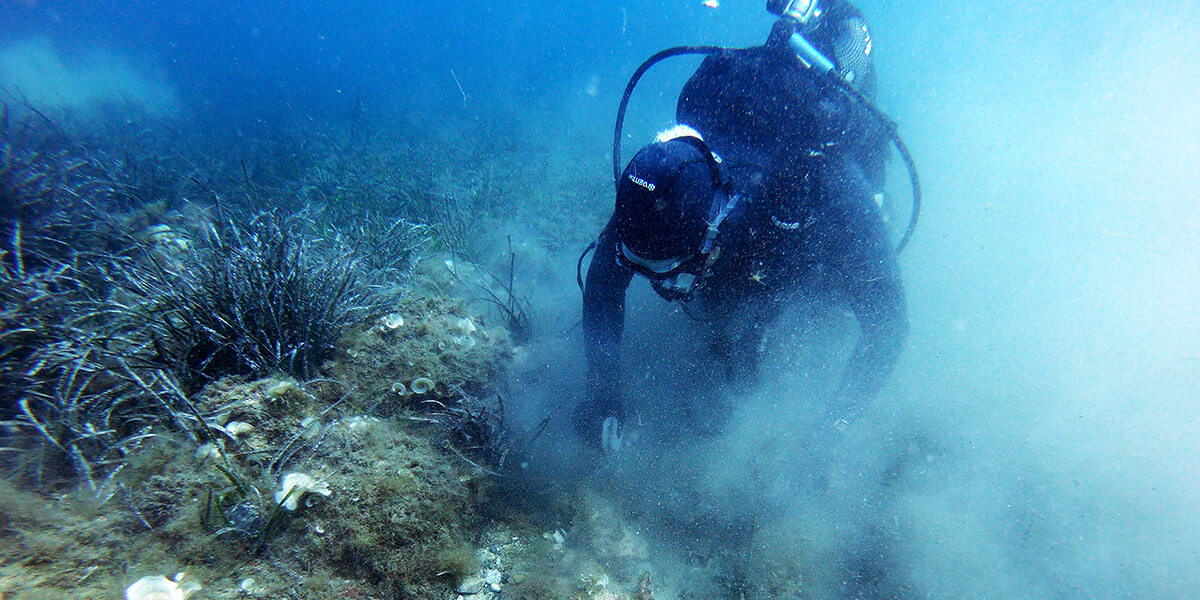There is almost total silence. Only the low hum of his air tank and the tiny roar of the billions of gallons of water surrounding him. Nick Bartos ’09 works steadily, 40 feet below the surface of the Mediterranean Sea, removing sediment from a 6th-century A.D. Roman shipwreck.
Ten thousand miles away, at the planet’s southern tip, Hank Woolley ’09 bends his head against icy winds on an 8,000-foot peak. He clears away snow and dirt to reveal the corner of an ancient fossil his team has just discovered in the mountains of Antarctica.
These are the lives and careers of two Colorado Academy alumni—former classmates and longtime friends—who grew up together taking biology, learning history, and developing their writing skills in CA’s Upper School.
Bartos and Woolley have distilled their multidisciplinary learning from CA to become an archaeologist and a paleontologist, respectively. Their adventurous careers in parallel fields bond them across miles and historical eras.
He can walk and draw underwater

It was the Marzamemi Maritime Heritage Project that took Lakewood, Colo., native Nick Bartos to a Roman shipwreck this past summer. His Stanford University project team used a small Sicilian fishing village as their jumping-off point to excavate the site in order to display their discoveries in a local museum.
During projects like this, Bartos—who specializes in maritime archaeology and works both at sea and on land—spends about six hours a day underwater in SCUBA gear. A heavy wetsuit keeps him relatively comfortable, depending on the season and location. He comes up to the surface only to change his oxygen tank and eat lunch.
He and his teammates use dredges—large suction tubes connected to motors floating on the surface—to systematically remove sediment from the wreckage. They survey and map the entire site, taking photos and setting up an underwater grid to record each item in its place.
“Being on an underwater excavation is a bit like being on the Moon,” says Bartos, who earned a bachelor’s degree from Brown University and a master’s from Oxford University and is now working on his PhD at Stanford. “You can take off your fins and walk on the bottom, and once you get good, you can stand, write, and draw underwater.”
That’s right: Pencils work underwater, so the scientists use special slates to communicate. That’s how Bartos shared the news with his supervisor when he and his colleague uncovered part of a carved marble pulpit—the large, expensive centerpiece of an ancient church.
“You realize you’re the first person to touch this thing in over 1,500 years. It’s an incredible adrenaline rush,” he says. “Sometimes, an underwater excavation is just like any other job, and a fish in your face is just like an annoying colleague. But the reason you do all this is for those times you uncover something truly remarkable.”

He thinks camping on the South Pole is easy

For five weeks, Hank Woolley camped in one of the coldest places on Earth. For the dinosaur bone hunter from Denver who’s been on digs everywhere from Utah to Madagascar, living on a glacier in Antarctica “felt like glamping.”
“We were helicoptered up to mountaintops, so we didn’t have to mountaineer much. We had Arctic Oven tents, electricity, a full kitchen, and a chef who made us three meals a day,” says Woolley, a PhD student at the University of Southern California and graduate-student-in-residence at the Natural History Museum of Los Angeles County. “And there was an amazing support staff and logistics team that enabled us to focus on our work.”
It’s this fieldwork that makes Woolley love his work as a paleontologist. It’s what made him go back to college for a bachelor’s degree in geology from the University of Colorado Boulder after his first BA in Medieval European History and French & Francophone Studies from Bates College.
“Every corner you walk around, you could find a fossil turtle skeleton, or a giant fish jaw, or a dinosaur skull,” he says. “Being on the edge of discovery, there’s no more visceral feeling than that.”
He also loves the idea that his work could make a positive difference in the world, specifically when it comes to understanding the biotic response to climate change. He studies fossil records and evolutionary patterns related to the planet’s five major extinctions, all of which involved a sudden warming event. He wants to determine how animals and ecosystems reacted to climate changes in Earth’s past in order to predict how they will react to global warming now.
“Understanding what kinds of animals go extinct because of warming events and what kinds of animals survive will help us predict and manage changes in our modern ecosystems, as well as make policy decisions on what lands to preserve and species to protect,” Woolley says.
He enjoys sharing his scientific findings and data about Earth’s history to help people understand how their actions affect ecosystems. He also just likes talking about hunting for dinosaur bones.
“I love telling people that I dig for dinosaurs for a career. I don’t think I’ll ever get tired of that,” he says.
The place that brought them together

Bartos and Woolley met at CA in the Fifth Grade. They became fast friends, going skiing together, playing CA Lacrosse together, and, later, inspiring one another along similar career paths.
Both of them remember the weeklong Fifth Grade field trip to Crow Canyon Archaeological Center in southwestern Colorado, their first introduction to archaeology and scientific fieldwork.
“CA faculty members were the best at instilling a curiosity for the world around us,” says Woolley, whose father (Charlie Woolley ‘72) and sister (Elsa Woolley ‘11) are also CA alumni.
As CA students, in addition to lacrosse, Bartos was into rock climbing and hockey, and Woolley played tennis, sang in the choir, and performed in musicals.
“CA is an amazing community with fantastic teachers,” says Bartos, whose interest in the sea was first sparked in Dr. Charles Coleman’s biology class. “It’s a great, well-rounded place with arts, academics, and athletics.”

Woolley agrees: “CA was so good at providing every student the opportunities to pursue what they wanted. And it’s so awesome that the class of 2009 has a paleontologist and an archaeologist in it.”
With their intensive work travel, face-to-face visits are rare, but the two keep in touch via email and texts. And though their paths don’t cross as often as they did in the halls of CA, the bonds they made there are still strong.
“He’s going to all the places I’m not going, and I’m going to all the places he’s not going,” Bartos says. “Together, we’ll conquer it all.”
